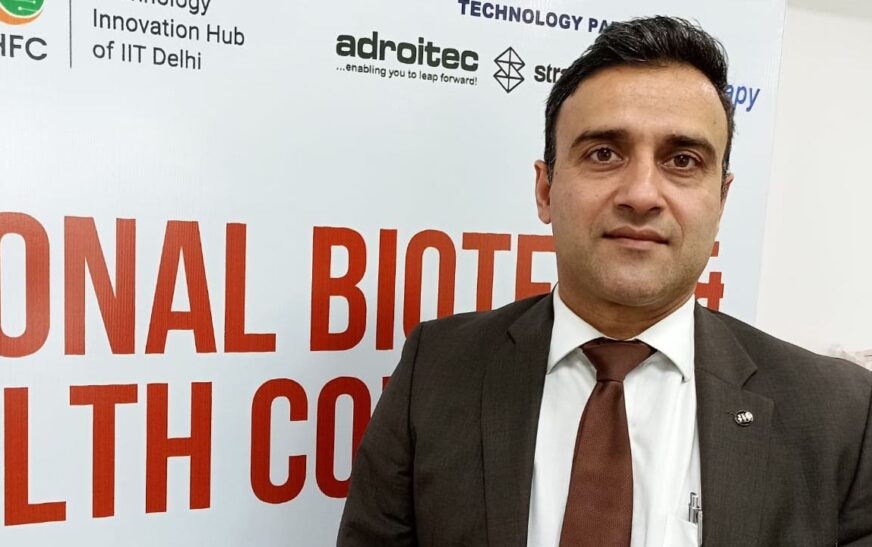Stratasys is at the forefront of the global shift to additive manufacturing, driving innovation with cutting-edge 3D printing solutions across industries like aerospace, automotive, consumer products, and healthcare. The company continuously redefines the boundaries of 3D printing, pushing for unprecedented levels of realism, accuracy, speed, and performance. By integrating intelligent 3D printers, advanced polymer materials, a robust software ecosystem, and on-demand parts, Stratasys delivers a competitive edge at every stage of the product lifecycle. Leading organizations worldwide rely on Stratasys to revolutionize product design, enhance manufacturing agility, streamline supply chains, and advance patient care.
In an exclusive conversation with The Interview World at NBHC 2024, Rahul Pandita, Regional Head – North, East India, and Karnataka, Stratasys India Pvt. Ltd., sheds light on the company’s trailblazing innovations in 3D printing for healthcare. He explores the evolving market dynamics and outlines Stratasys’ strategy for the Indian market. Pandita highlights the company’s unique strengths in additive manufacturing, unveils plans for upcoming 3D printing solutions tailored for India, and emphasizes the vast opportunities within this rapidly growing market. Here are the key insights from this engaging discussion.
Q: Could you elaborate on Stratasys’ innovations in 3D printing for healthcare, market evolution, and India’s role in your strategy?
A: Globally, Stratasys stands apart with proprietary technologies unmatched by any other company in the world. While 3D printing adoption in India remains modest today, the trajectory is promising. The sector is gradually evolving, with healthcare showing a marked improvement in adoption compared to three to five years ago, largely due to government initiatives. Prime Minister Modi’s emphasis on Atmanirbhar Bharat has fostered greater collaboration between academia and industry, creating a fertile ground for growth in additive manufacturing.
We collaborate with leading global healthcare giants such as Medtronic, Stryker, Boston Scientific, and Baxter, which operate substantial R&D offshore development centers in India. These centers leverage Indian talent—our country is not lacking in skilled professionals. With advanced technology providers like Stratasys already in place, the challenge lies in fostering collective innovation. To bridge this gap, we also need a stronger push for R&D initiatives, industry-focused innovation hubs, and government incentives to encourage the development of indigenous products. Furthermore, these measures would catalyze growth, enabling India to shift from being a service hub for global healthcare companies to a center of groundbreaking innovation.
At present, most of India’s contributions to healthcare revolve around manufacturing and servicing for large international firms. While the pharmaceutical sector is robust, innovation-driven R&D in healthcare still lags. However, the direction is encouraging, and strides are being made. Although other competitors play their roles, Stratasys remains uniquely positioned with its distinctive product offerings, driving progress and shaping the market.
Q: How does Stratasys differentiate its 3D printing solutions from global competitors in terms of technology and innovation?
A: When it comes to healthcare, our digital anatomy printer stands out as a groundbreaking technology unmatched anywhere in the world. As pioneers in this space, we pride ourselves on relentless innovation, which lies at the core of our company’s strategy. For instance, the radiometric material we introduced just six to twelve months ago exemplifies our commitment to staying ahead of the curve.
Continuous innovation is not just a choice—it is essential for success in today’s rapidly evolving world. Disruption is constant, and new technologies emerge at an unprecedented pace. To remain leaders in this dynamic landscape, we must consistently push boundaries. There is no room to sit back and relax; staying proactive is the only way forward.
Q: What innovative products or solutions is Stratasys planning to launch in India, reflecting its commitment to innovation?
A: We recognized early on that cost barriers associated with advanced technologies needed to be addressed, particularly in price-sensitive markets. Customers in these regions are understandably hesitant to invest half a million or a million dollars in a single machine. In India, this challenge is even more pronounced, as affordability remains a key factor driving purchasing decisions.
To bridge this gap, we are preparing to launch a smaller, more cost-effective version of our printer by the end of 2024. This strategic move aims to make our cutting-edge technology more accessible to customers who prioritize value without compromising quality. We are currently planning an event to mark this milestone and anticipate unveiling the J5 Digital Anatomy Printer by mid-December. This innovation promises to redefine affordability in advanced 3D printing solutions while maintaining the excellence we are known for.
Q: What opportunities does the Indian market present for Stratasys, and how do you plan to leverage them effectively?
A: We are undoubtedly moving in the right direction. With increasing industrial setups and a stronger focus on technology, the adoption of 3D printing is gaining momentum. Just three years ago, there was only one printer of this caliber in the country. Today, that number has also grown to six or seven—a clear indication of progress. This upward trajectory fills me with optimism about the future of 3D printing in India. The potential is immense, and we are well on our way to realizing it.








